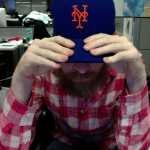
In 2011, Enjoi Skateboards' art director Winston Tseng did something a little bit out of the ordinary; he put together a book—Warning: The Art of Marc McKee—highlighting the art of another skateboard artist, one whose work he discovered as a skater in the '90s. Fast-forward to 2014, and Tseng had traded his art director job to one as a publisher. In 2011, he founded the publishing house WINS, and today he is releasing the third book in his series, Look Away: The Art of Todd Francis. (The second, I Hate: The Art of Todd Bratrud, was released in 2011 as well.) Tseng's series was a way to not only honor some of his early heroes, but a vehicle to spread their work to a wider audience.
"The idea for this book series came about because there had been a good amount of books about skate art," Tseng told Complex in an interview, "but they would lump it all together and have all the artists in there as one. And I thought that it didn’t give enough credit to the artists themselves and show how different each of their styles and their artwork was."
All three of the artists Tseng profiled—Marc McKee, Todd Francis, and Todd Bratrud—have done more than just decks. And the books, slim as they are—no need for a coffee table here—do a wonderful job displaying the range of each of their outputs, from ads to T-shirt graphics to (in Francis' case) rather morbid Christmas decorations. Tseng recently stopped by the Complex offices to talk about his books (all three are available here) as well as his new career as a book publisher.
Interview: Art Director Winston Tseng Talks His Book "Look Away: The Art of Todd Francis"

Anything that was on a skate shop wall throughout the ‘90s was my inspiration.
Why did you pick Marc McKee for your first book?
I knew Marc from working at Enjoi—he’s been at World and Dwindle for so long. He just seemed to fit a lot of the things I wanted to do really well. To anyone outside the industry, maybe he hasn’t been credited enough for his work, and I wanted to highlight him. Personally, I grew up skating from the early ‘90s and on, so as a fan from my perspective, he was a huge influence. It just felt right for a lot of reasons to give him the first one.
Did you come at skateboarding from an art perspective, or was it the other way around?
It was completely the other way around. I just grew up skating with my friends, and that led to artwork. My whole basis comes from skateboarding. That’s how I got to want to work in the industry.
Did these artists you wrote about influence your own style, art-wise?
I would never compare myself to any of these guys [laughs]. More than anything, more than their style, their careers and their full bodies of work have really influenced me and been inspiring. These guys all have very distinct styles that they’re known for, that they not only apply to their work in skateboarding. When they do other work, personal work, it’s really their artwork that’s just getting used in different ways. That’s definitely influenced me in where I’d like to eventually take my own work at some point.
Have you noticed a shift from since 2011, when your first book on McKee was published, to 2014 in how skate artists are seen?
I think so, but maybe because I’m such a fan of it, I’m reading into it too much. A lot of these artists aren’t even showing their work they’ve done on skateboards anymore. It’s not even about showing the boards anymore. They’re just showing their paintings or their prints or whatever it might be. People are definitely receptive to their work.
Did these guys open up their archives to you, or did you have to primarily work from decks? Do these guys have all the original stuff?
It was pretty amazing. That was one of the most fun things about working on this with these guys. They’ve been keeping their work around for like 20 years now, and my books are pretty small, so it was a lot of work to edit down for a format like this. We started going through all their stuff—boxes, flat files, all sorts of old stuff—it was pretty cool.
Stuff they probably hadn’t looked at in a while either.
Totally. That was the interesting thing about my position in this; I could look at it and give them a perspective on what people might be excited to see. There were definitely some tough calls as far as what made the cut for each of them, but I think the artists were definitely happy with how they came out, and then I think the viewers are hopefully happy too.

At this point it seems like people in our world know about them, but hopefully doing these books legitimizes them even more and brings their work to another audience.
Was it cool for you as an artist to see how these guys work? Was that part of the appeal of doing this project too?
It’s kind of a way I figured out to meet some of my idols for sure. I started working in the industry in the early 2000s or so. I wasn’t working in the ‘90s when a lot of these guys were. Their techniques and processes were so different. Most of their stuff was hand drawn instead of doing it directly on the computer. So, I would go between fanning out the whole time and being the one to put this all together.
They probably have an easier time talking to you, too, since you come from sort of the same background.
I think that definitely helped. I hope that helped. I knew Marc and Todd Bratrud from before working with them, from my work with Enjoi. But Todd Francis I had never met before until I approached him with this project. I think that my background and the fact that we had done these two books made it easy for him to say, "Yeah, I wanna do that."
Were there particular skateboard artists you looked up to when you were growing up?
Basically these guys that I’ve been working with, almost in this order. Anything that was on a skate shop wall throughout the ‘90s was my inspiration. At the time I didn’t know anything about the artists behind it. As a kid I just liked what I saw. I didn’t know who Marc McKee was at that time, I just knew that I liked his graphics.
How did you find out who these guys were? Was it not until later?
I don’t really remember exactly how I found out who they were. Maybe at some point it was on the Internet or through books like Disposable, probably. That might have put some names to the works for me. At this point it seems like people in our world know about them, but hopefully doing these books legitimizes them even more and brings their work to another audience.
Do you see yourself doing a book of your on work at some point? I know you don’t put yourself on the same level, but you’ve got the opportunity.
It’s funny, I’ve gotten that question before, and again, I don’t put myself on the same level. And I would feel weird doing it about myself, but maybe someday if my work gets to that level and someone really wants to do it.
Someone else could compile it.
It would have to be something like that, I think. It would be a little weird to put out a series of all these great artists and then tack myself on at the end [laughs].
What else do you see yourself doing with the imprint?
The goal was never to necessarily become a publisher. The first year I worked with another publisher, but I thought it would work out better if we did this ourselves. I’d love to continue to produce books. I like tangible objects, and I like things that I think are worthwhile. But I have a lot of other interests. I think there’s a lot more to do in skateboarding, and then if there’s a way to do it that makes sense, there’s a lot of interests outside skateboarding that I’d like to highlight.

The official release event and signing for Look Away: The Art of Todd Francis will be at Hennessey + Ingalls in Los Angeles on Thursday, June 26 from 6 – 9 p.m.

